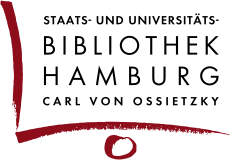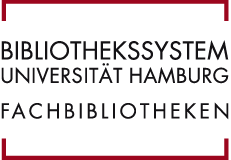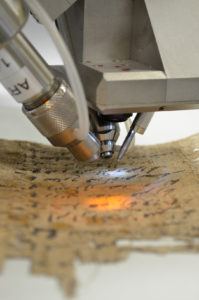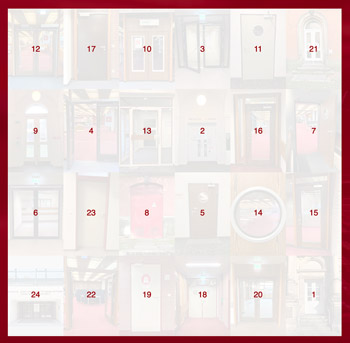Nun im Diamond Open Access: die Zeitschrift manuscript cultures des CSMC
14. August 2024
von Redaktion — abgelegt in: E-Medien,Hamburg University Press — 2.301 Aufrufe
Von Dr. Oliver Krüger.
Bei manuscript cultures handelt es sich um eine frei verfügbare wissenschaftliche Zeitschrift, die sich der Erforschung von Schriftartefakten weltweit widmet. Ab der Ausgabe 24 wird manuscript cultures von Hamburg University Press, dem Open-Access-Publikationsdienst der Staats- und Universitätsbibliothek Hamburg, gehostet. Damit erscheint die Zeitschrift zukünftig als Diamond-Open-Access-Zeitschrift. Beim Diamond Open Access fallen keine Kosten für Lesende und Autor:innen an. Während die technische Infrastruktur von einer wissenschaftlichen Bibliothek zur Verfügung gestellt wird, liegt die inhaltliche Verantwortung weiterhin allein in den Händen des Herausgeber-/Redaktionsteams und somit der wissenschaftlichen Gemeinschaft.
Zur Zeitschrift
Die Zeitschrift manuscript cultures wird vom Centre for the Study of Manuscript Cultures (CSMC) herausgegeben, das seit 2019 Standort des Exzellenzclusters Understanding Written Artefacts ist. Die Zeitschrift wurde 2008 als wissenschaftlicher Newsletter der Forschergruppe ‚Manuscript Cultures in Asia and Africa’ gegründet und 2011 in eine wissenschaftliche Zeitschrift umgewandelt. Mit der Ausgabe 24 übernimmt ein neues interdisziplinäres Redaktionsteam, das von einem neuen internationalen wissenschaftlichen Beirat unterstützt wird. Die Zeitschrift hat sich zum Ziel gesetzt, Schriftartefakte aus interdisziplinären Perspektiven zu untersuchen. Es werden neue Ansätze für die Erforschung von Schriftartefakten vorgestellt, die von den Erkenntnissen der Geistes-, Natur- und Informationswissenschaften und der Zusammenarbeit zwischen ihnen profitieren. Mit dem Begriff Schriftartefakt, unter den alle handschriftlichen Erzeugnisse fallen können, wird dabei die enge Definition von Manuskript als ‚handgeschriebenem Buch’ hinterfragt und erweitert, indem etwa Inschriften, Archivdokumente und Graffiti genauso eingeschlossen werden wie jedes andere handschriftliche Produkt. Insbesondere sind vergleichende Ansätze zu Schriftartefakten über geografische, kulturelle und zeitliche Sphären sowie traditionelle disziplinäre Grenzen hinweg von Interesse, die zu einem größeren historischen und globalen Überblick über die Rolle von Schriftartefakten in vergangenen und heutigen Kulturen beitragen. Auf diese Weise bietet manuscript cultures eine neue Grundlage für laufende Diskussionen zu Schriftartefakten im weiten Feld der Kulturwissenschaften.
![]() Die Zeitschrift manuscript cultures veröffentlicht die Artikel einer Ausgabe sukzessive im Laufe des Jahres. Die ersten Beiträge zur ersten Ausgabe (Band 24, 2024) nach der Migration in das Zeitschriften-Hosting von Hamburg University Press befassen sich mit buddhistischen illustrierten Drucken aus dem Dunhuang des zehnten Jahrhunderts, der spätantiken Überlieferung von Aristoteles’ Organon, der esoterischen Bedeutung des Shabbat-Tisches und des Brotes in der lurianischen Kabbala sowie Manuskriptkarten aus der Sammlung Harrer im Völkerkundemuseum der Universität Zürich.
Die Zeitschrift manuscript cultures veröffentlicht die Artikel einer Ausgabe sukzessive im Laufe des Jahres. Die ersten Beiträge zur ersten Ausgabe (Band 24, 2024) nach der Migration in das Zeitschriften-Hosting von Hamburg University Press befassen sich mit buddhistischen illustrierten Drucken aus dem Dunhuang des zehnten Jahrhunderts, der spätantiken Überlieferung von Aristoteles’ Organon, der esoterischen Bedeutung des Shabbat-Tisches und des Brotes in der lurianischen Kabbala sowie Manuskriptkarten aus der Sammlung Harrer im Völkerkundemuseum der Universität Zürich.
Diamond Open Access auf der Höhe der Zeit
Ab der Ausgabe 24 veröffentlicht manuscript cultures nach den Standards und Richtlinien von Hamburg University Press. Zu diesen Standards gehören formale Qualitätsstandards, wie ausführliche Zeitschriften-Informationen (z. B. ethische Richtlinien), Konzepte für den Umgang mit Mehrsprachigkeit, eine wissenschaftsfreundliche, einfache Nachnutzung ermöglichende Rechtepolitik (Creative-Commons-Lizenzen, hier CC-BY), vollständige, konsistente Artikel-Metadaten, Indexierung und Langzeitarchivierung. Die Artikel sind für Leser:innen kostenlos verfügbar. Zudem verlangt die Zeitschrift keine Artikelgebühren (Article Processing Charges) von Autor:innen. Damit erfüllt manuscript cultures alle Kriterien einer Diamond-Open-Access-Zeitschrift. Die Redaktion der Zeitschrift liegt vollständig in der Hand der Wissenschaft und steht damit im Einklang mit dem wissenschaftsgeleiteten Publizieren (scholar-led publishing). Hamburg University Press garantiert zudem die nachhaltige Verfügbarkeit sowie die Archivierung der Artikel und Ausgaben.
SUB als Partnerin der Wissenschaft
Die SUB freut sich gemeinsam mit allen Beteiligten über die erfolgreiche Migration wie auch darüber, dass die Zeitschrift uns als Partnerin für ihre Veröffentlichung gewählt hat. Zukünftig wird das Publikationsangebot von manuscript cultures noch ausgebaut und um innovative Ansätze zur digitalen Darstellung von Schriftartefakten erweitert.
Neue Webseite von manuscript cultures: https://journals.sub.uni-hamburg.de/mc.
Now Diamond Open Access: the CSMC’s journal manuscript cultures
By Dr. Oliver Krüger.
The open access journal manuscript cultures is a freely available scholarly journal dedicated to the study of written artefacts world-wide. Starting with issue #24, manuscript cultures will be hosted by Hamburg University Press, the open access publication service provided by the Hamburg State and University Library. From now on, the journal will be published as a Diamond Open Access journal. Diamond Open Access means that the digital publication is free of charge for authors and readers. While the technical infrastructure in provided by a research library, the responsibility for the journal remains with the editorial board and therefore in the hands of the scholarly community.
About the journal
The journal manuscript cultures is published by the Centre for the Study of Manuscript Cultures (CSMC), which has hosted the Cluster of Excellence Understanding Written Artefacts since 2019. Initially established as the newsletter of the research group ‘Manuscript Cultures in Asia and Africa’ in 2008, manuscript cultures was transformed into a scholarly journal in 2011. With issue 24, a new interdisciplinary editorial team takes over, supported by a new scientific advisory board. The aim of manuscript cultures is to examine written artefacts from an interdisciplinary perspective. It presents new approaches to the study of written artefacts that benefit from the insights offered by the humanities, natural sciences and information sciences and the collaboration between them. Written artefacts can include all handwritten products. Focussing on the written artefact, the journal challenges and transcends the restrictive definition of manuscript as ‘the handwritten book’ by including epigraphs, archival documents, graffiti and any other product of handwriting. In particular, it promotes comparative approaches to written artefacts across geographic, cultural, and temporal spheres, as well as traditional disciplinary boundaries, that contribute to a larger historical and global survey of the role of written artefacts in ancient and modern cultures. In doing so, manuscript cultures provides a new foundation for ongoing discussions in the broad field of cultural studies.
![]() The journal manuscript cultures publishes the articles of an issue successively over the course of the year. The first contributions to the first issue (volume 24, 2024) after the migration to the hosting service by Hamburg University Press deal with illustrated Buddhist prints from tenth-century Dunhuang, the late-antique transmission of Aristotle’s Organon, the esoteric meaning of the Shabbat table and bread in the Lurianic kabbalah, and manuscript maps from the Harrer collection at the Ethnographic Museum at the University of Zurich.
The journal manuscript cultures publishes the articles of an issue successively over the course of the year. The first contributions to the first issue (volume 24, 2024) after the migration to the hosting service by Hamburg University Press deal with illustrated Buddhist prints from tenth-century Dunhuang, the late-antique transmission of Aristotle’s Organon, the esoteric meaning of the Shabbat table and bread in the Lurianic kabbalah, and manuscript maps from the Harrer collection at the Ethnographic Museum at the University of Zurich.
Diamond Open Access at the cutting edge
Starting with issue #24, manuscript cultures publishes according to the standards and policies of Hamburg University Press. These standards include formal quality standards such as detailed journal information (e.g. ethical guidelines), concepts for dealing with multilingualism, a scholarship-friendly rights policy that allows re-use (Creative Commons licenses, here CC-BY), complete, consistent article metadata, indexing and long-term archiving. The articles can be accessed by readers free of charge. In addition, the journal does not charge article processing charges. This means that manuscript cultures fulfills all criteria of a Diamond Open Access journal. The editing of the journal is entirely in the hands of the editorial board and is therefore in line with scholar-led publishing.
SUB as a partner of research
The SUB highly appreciates that the CSMC editorial board has chosen us as a partner for its publication and is pleased with the forward-looking cooperation that has resulted in the successful migration. In the future, publications offered by manuscript cultures will be enhanced with the aim to include innovative approaches to the digital presentation of written artefacts.
New website of manuscript cultures: https://journals.sub.uni-hamburg.de/mc.
 EN English
EN English
 FR Français
FR Français
 ES Español
ES Español
 TR Turkce
TR Turkce
 RU Pусский
RU Pусский
 AR العربية
AR العربية
 CN 中国
CN 中国
 NDS Plattdeutsch
NDS Plattdeutsch





